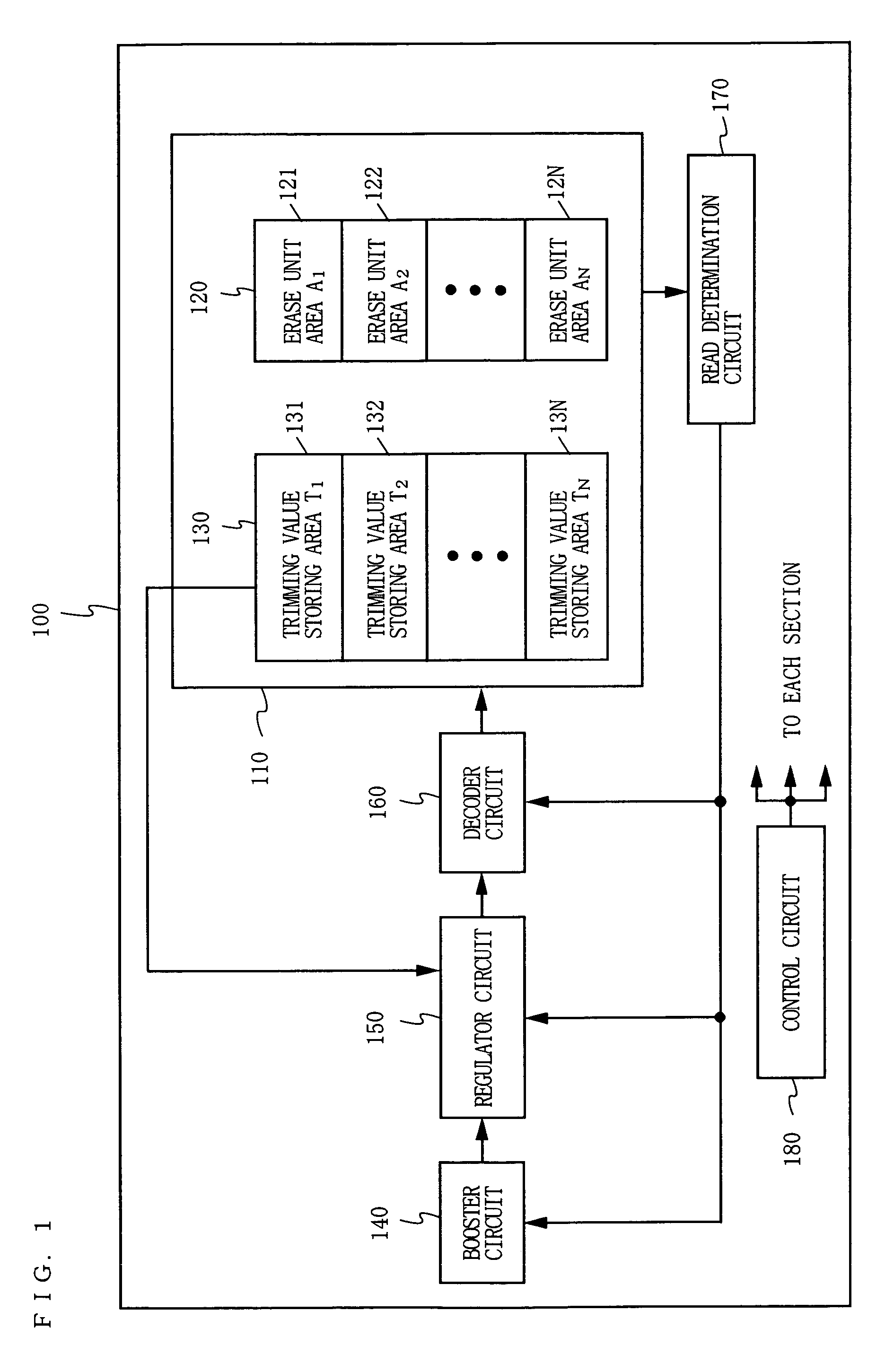Non-volatile memory device with threshold voltage control function
a non-volatile memory and threshold voltage technology, applied in static storage, digital storage, instruments, etc., can solve the problems of inability to accurately read out data accumulated in memory cell transistors, inability to uniformly perform rewrite operations for all erase unit areas, and inability to improve the number of rewrite operations.
- Summary
- Abstract
- Description
- Claims
- Application Information
AI Technical Summary
Benefits of technology
Problems solved by technology
Method used
Image
Examples
first embodiment
[0054]FIG. 1 is a diagram illustrating a structure of a flash EEPROM according to a first embodiment of the present invention. The flash EEPROM 100 of FIG. 1 comprises a memory cell array 110, a booster circuit 140, a regulator circuit 150, a decoder circuit 160, a read determination circuit 170, and a control circuit 180. The memory cell array 110 includes N erase unit areas 121 to 12N, and N trimming value storing areas 131 to 13N. Among these components, the booster circuit 140 functions as a voltage generating circuit, the regulator circuit 150 functions as a voltage regulating circuit, and the trimming value storing areas 131 to 13N function as output regulating value storing sections.
[0055]The memory cell array 110 includes a plurality of memory cell transistors arranged in an array. Each memory cell transistor has a floating gate for accumulating electric charge so as to store data in a non-volatile manner. The memory cell transistor is subjected to a step of injecting electr...
second embodiment
[0078]A flash EEPROM according to a second embodiment of the present invention has the same structure as that of the first embodiment (see FIG. 1). FIG. 3 is a flowchart illustrating a rewrite operation in the flash EEPROM of the second embodiment. This flowchart is obtained by replacing step S260 with step S360 in the flowchart of FIG. 2.
[0079]The flash EEPROM of the second embodiment is different from the flash EEPROM of the first embodiment in the following. In the flash EEPROM of the second embodiment, the regulator circuit 150 outputs a higher level of post-regulation erase / write voltage as the number of “0”s included in an input trimming value is increased.
[0080]In the flash EEPROM of the first embodiment, a trimming value is erased in step S260. By contrast, in the flash EEPROM of the second embodiment, a trimming value is erased only in the first performance of step S360 (i.e., only when step S360 is performed for the first time with respect to a selected trimming value) as ...
third embodiment
[0086]FIG. 4 is a diagram illustrating a structure of a flash EEPROM according to a third embodiment of the present invention. The flash EEPROM 400 of FIG. 4 is obtained by adding a trimming value temporarily holding circuit 405 to the flash EEPROM of the second embodiment. FIG. 5 is a flowchart illustrating a rewrite operation in the flash EEPROM 400 of the third embodiment. This flowchart is obtained by shifting steps S260 and S361 of the flowchart of FIG. 3 to steps S560 and S561, and adding step S551 to the original positions of steps S260 and S361.
[0087]The flash EEPROM of the third embodiment is different from the flash EEPROM of the second embodiment in the following. The flash EEPROM 400 of the third embodiment comprises the trimming value temporarily holding circuit 405 in addition to the components of the flash EEPROM of the second embodiment. The trimming value temporarily holding circuit 405 is a volatile memory section composed of, for example, a CMOS circuit or the lik...
PUM
 Login to View More
Login to View More Abstract
Description
Claims
Application Information
 Login to View More
Login to View More - R&D
- Intellectual Property
- Life Sciences
- Materials
- Tech Scout
- Unparalleled Data Quality
- Higher Quality Content
- 60% Fewer Hallucinations
Browse by: Latest US Patents, China's latest patents, Technical Efficacy Thesaurus, Application Domain, Technology Topic, Popular Technical Reports.
© 2025 PatSnap. All rights reserved.Legal|Privacy policy|Modern Slavery Act Transparency Statement|Sitemap|About US| Contact US: help@patsnap.com



